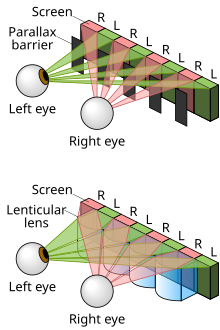
Back Barrera de paral·laxi Catalan Barrera de paralaje Spanish Barriera di parallasse Italian 시차 장벽 Korean Sawar paralaks Malay Щелевой растр Russian 视差障壁 Chinese

A parallax barrier is a device placed in front of an image source, such as a liquid crystal display, to allow it to show a stereoscopic or multiscopic image without the need for the viewer to wear 3D glasses. Placed in front of the normal LCD, it consists of an opaque layer with a series of precisely spaced slits, allowing each eye to see a different set of pixels, so creating a sense of depth through parallax in an effect similar to what lenticular printing produces for printed products[1][2] and lenticular lenses for other displays. A disadvantage of the method in its simplest form is that the viewer must be positioned in a well-defined spot to experience the 3D effect. However, recent versions of this technology have addressed this issue by using face-tracking to adjust the relative positions of the pixels and barrier slits according to the location of the user's eyes, allowing the user to experience the 3D from a wide range of positions.[3][4] Another disadvantage is that the horizontal pixel count viewable by each eye is halved, reducing the overall horizontal resolution of the image.[5]
- ^ Howard, Bill (2003). "Reviews by PC Magazine - Sharp Actius RD3D". www.pcmag.com. Archived from the original on 20 April 2008. Retrieved 25 January 2008.
- ^ "The Register - Sharp's 3D LCD: how's that work, then?". www.theregister.co.uk. 2004. Retrieved 25 January 2008.
- ^ no specified authors . (2015). New Nintendo 3ds. December 28, 2016, by Nintendo of America Inc Website: https://www.nintendo.com/3ds/new-nintendo-3ds/
- ^ Norris, Ashley (6 December 2002). "Guardian Unlimited - Special reports - The return of 3D". London: www.guardian.co.uk. Retrieved 25 January 2008.
- ^ "Better glasses-free 3-D". Retrieved 1 July 2011.
A fundamentally new approach to glasses-free 3-D displays could save power, widen the viewing angle and make 3-D illusions more realistic.